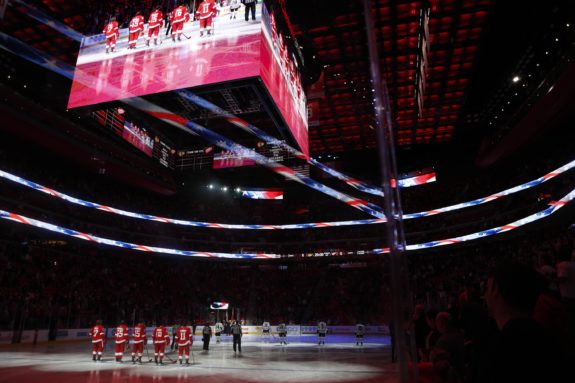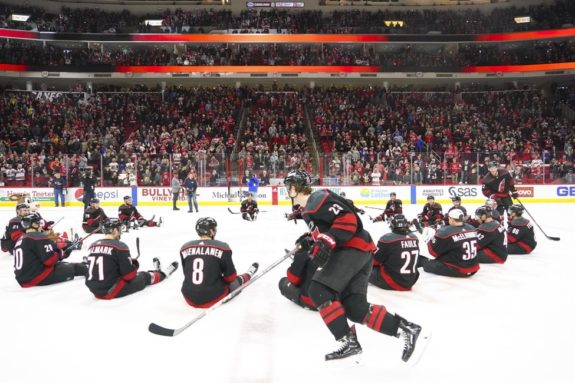Over the past few weeks, stories about the worries of NHL attendance have been drastically overstated. It all started with a Canadian Press article that claimed NHL teams were worried fans would rather stay home and watch the games in lieu of going to the arena. The Associated Press cited the rebuilding Detroit Red Wings as their main case study. It was an interesting choice of team, as the Red Wings remain one of the most popular and decorated NHL franchises south of the Canadian border, yet are in the middle of a drastic rebuild that doesn’t see them playing competitive hockey for the next few seasons.
It’s understandable that the NHL would want to increase attendance. Not only does NHL attendance lag behind not only the four major sports, but behind Major League Soccer as well. Throughout it’s entire existence, the NHL has had to fight for market space with the United States media, but to panic over a few empty seats in Detroit seems a bit exaggerated.

The Red Wings weren’t the only teams examined by the Associated Press, as they took a less detailed look at the Carolina Hurricanes as well. The Hurricanes are coming off an appearance in the Eastern Conference Final, their first playoff appearance in 10 years. The Hurricanes used a nontraditional method to ramp up attendance last season: monthly passes. It might have worked to a certain degree for the Hurricanes, but can the NHL adopt them as a whole?
What Are They Exactly?
In a sense, the passes are basically season tickets for a month. Fans pay one amount and get access to home games during that time period. Such ticket types have been in use in Major League Baseball (MLB) for some time, yet the Carolina Hurricanes were the first to experiment with it in the NHL.
The Hurricanes explained their main motivation behind the decision:
“It gets people in the building for an affordable price,” Hurricanes vice president Mike Forman said. “We think if we can get people to a game, they’re hooked.”

What Forman didn’t explain is that the concept allows repeat visitors. People who bought the pass with the intention of going to certain games might end up going to more than anticipated. Although the gate receipt from those fans remain the same, it affords the team and arena a chance to earn more profit off additional food, beverage, concession and gift shop revenue. Sometimes those profit margins can be even higher than game tickets. They say, “if you build it, they will come,” but in the world of professional sports, “if you build it, they will spend.” Assuming the fans who brought the Hurricanes monthly pass went to every game and made the most of their investment, you’d think the Hurricanes lost some revenue, but they more than likely made up for it in $15 beers and $10 hot dogs.
Potential Problems
While from a hockey fan perspective the deal might seem too good to be true, there are a few logistical problems with the concept. Starting off with the first minor one, for one, what would be the resale value of the tickets?
Let’s assume you bought into one of the passes and decided you couldn’t make it to a certain game and decided to resell your ticket on an aftermarket website such as StubHub? How would that process work? As much as some sports organizations don’t like the resell market (the New York Yankees had a notable rift with StubHub in 2015 and 2016 before reconciling), they should embrace them, as they allow empty seats to be filled.
Second, and most importantly, where are the fans sitting and how is the program structured? The Associated Press pointed to the examples that MLB teams have done in the past, but let’s take a look at the Yankees comparable promotion, which was available for home games this past September.
The Yankees Ballpark Pass, as it was called, only guaranteed general admission, standing room only, access to fans. That’s easy for a baseball stadium to do, as they’re built with standing room only areas and bleacher sections in mind. Even if you don’t assign someone a physical seat, it’s easy to get them in the gate. Hockey rarely has such a thing. A look at ESPN’s attendance statistics from last season that seven teams had a capacity of over 100% attendance, assuming anything over 100% was in the form of standing room only. One of those teams was the league’s newest stadium in Las Vegas for the Vegas Golden Knights, which we can assume was built with standing room areas.
The easiest way for these passes to work would be if they were all on the same level, as in standing room only and general admission. If fans are assigned a physical seat, then the team would have to worry about the logistics of making sure the seats being sold are not already purchased, and if premium seats for the monthly pass would offer premium prices. Offering a different seat for each game, such as accommodating what different seats had already been sold for different games, might be too confusing to implement.
Also of note from the New York Yankees example is that the pass is entirely digital, as most ticketing is done nowadays. However, the specific QR codes for each game don’t become available on the user’s phone until two hours before game time. The shorter period of time the buyer actually has the tickets cuts down on the possibility of a re-sale, although that’s not a fool-proof system, as you can always sell the ticket in advance and provide the QR code once it become available.
Is There a Solution?
In an earlier article here on The Hockey Writers, I discussed emerging trends in the construction of new baseball stadiums, and how that might carry over to the NHL. One of the concepts gaining steam in baseball stadium construction is the implementation of large, open, almost communal areas. Think of a place where people can gather and hang out, while a game just happens to be going on in the background. The Cleveland Indians’ Progressive Field turned some unused seating into the new area, and the Oakland A’s new baseball stadium is expected to include similar features.

While it may be difficult for older stadiums to repurpose themselves, these new, open areas are perfectly made for these “standing room only, general admission” type of tickets. With each new stadium the NHL builds, we might expect some similar areas. NHL arenas are significantly more compact than baseball stadiums, so finding a place to fit them might be a challenge. However, if the price is right, it’s an opportunity some might open their wallets to experience.